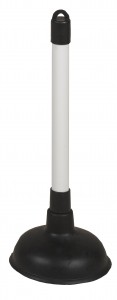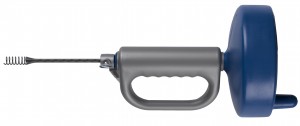Unblocking drains
Unblocking drains is never the most enjoyable of DIY jobs, and in many circumstances you may need to get the professionals in, but simple blockages (if there is such a thing!) normally have a fairly straightforward quick fix. In order to be prepared, shown below are three pieces of equipment I always have to hand should a blockage occur, somewhere in my waste and drain system. The good news is that none of these items are expensive, and all of them could save you a lot of money on calling out the pros to deal with your blocked drains.
Plungers

The simple plunger – sometimes simple is still best.
The humble cup-shaped plunger is still one of the most effective tools for dealing with many blockages.
They are ideally suited to use with basins, showers and sinks, and to see a typical unblocking sequence, take a look at my guide ‘Unblocking a kitchen sink’.
You will also see a few other designs of plunger in the shops, such as those which ‘fire’ a jet of water down into the blockage, but to be honest, the standard original design shown to the right still seems to do the job for me.
It’s also worth bearing mind that for unblocking a toilet, a simple plunger can sometimes be the best option, but you’ll need one with the large cup size in order to span the opening to the trap section of your toilet.
Therefore, your first purchase for any drain unblocking equipment should normally be the plunger.
Drain augers
Drain augers are another essential piece of equipment for me as if the plunger doesn’t work, an auger will get you right down into the thick of the blockage, literally.

Augers are ideal for access around the bends of small diameter waste pipes.
Augers are basically long bending springs which can be fed down into your waste, or drainage system, and then by rotating the auger handle slowly, you can burrow into the blockage and break it up.
What is particularly clever is that because they are so thin and bendy, they can often be fed down through plug holes, and around the bends of smaller waste pipes.
The link provided above shows an auger in action when unblocking a sink, but they can also be used for simple blockages in toilets.
Drain rods

Drain rods allow you to get right down to the blockages in underground drainage pipes.
Sometimes unblocking drains requires lifting manhole covers and clearing the underground drainage pipes. This is where you will require drain rods to push down into the pipes, locate the blockage and with a little pushing and turning, break the blockage up.
You simple feed the drain rods into the underground pipes by connecting one to the next as you gradually push down into the drainage system. Ensure that you screw each section together tightly and with most (if not all rod designs), only ever rotate the rods clockwise, as going anti-clockwise may unscrew sections and you could end up leaving rods underground, and therefore doubling your problem as you’ll have to dig up the drains to get them out.
Some final thoughts for unblocking drains
- Make sure you wear appropriate protective equipment.
- Whichever tools you use or require, remember that all of them require disinfecting after use.
- Not mentioned above are the chemical cleaners/unblockers. These can be very effective but you must be absolutely precise on following manufacturer’s guidelines, as the chemicals used are normally seriously toxic, and therefore require the utmost respect. Examples of guidelines include never mixing different chemical cleaners, and never use them in conjunction with a plunger. However, you can also find ‘greener’ chemical options now, which are once again another alternative.
- If in doubt when unblocking drains, seek professional advice, and with serious blockages, the professional option may be the only way.
- Finally, try to do all you can to avoid blocking drains in the first place by taking care in what actually goes down sinks, baths, showers and toilets in your home.
